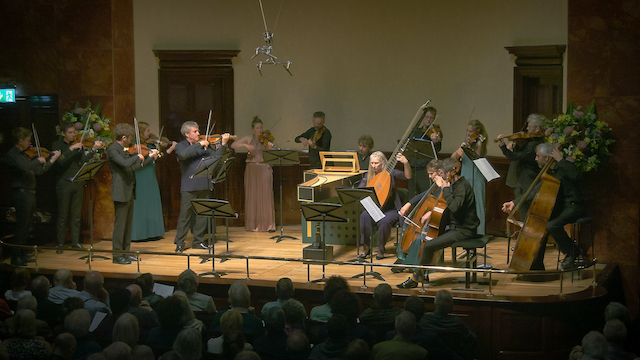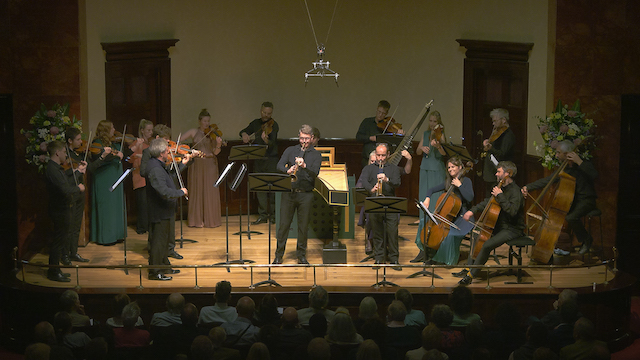When Giuseppe Torelli made the journey from his birthplace of Verona to Bologna in the late 17th century, the trumpet was still seen as something of a brash outsider, suitable for military displays but not for sophisticated music ensembles. Within decades, it would seem perfectly natural for both Vivaldi and Bach to write major works featuring the trumpet.
But both owed a considerable debt to Torelli who – beyond being Vivaldi’s teacher – put the instrument on the map by composing 30 concertos for it. So it’s not difficult to see why La Serenissima launched its glorious, vibrant celebration of Bologna in the 17th and 18th centuries with Torelli’s Concerto in D for two trumpets, strings and continuo. Following the elegant sweep of the Largo assai, with its exquisite dissonances, Simon Munday and Matthew Wells made their entrance on trumpets in the second Allegro movement, bringing a blaze of metallic colour to the vigorous textures created by the strings. For the third Adagio e staccato – Adagio movement, a stately melancholy presided, tilting briefly into a joyful helter-skelter before returning to sobriety. The final Allegro movement whipped up into an elegant three-time dance, to which Munday and Wells brought a rich, shimmering allure.
La Serenissima’s founder Adrian Chandler was very much at the helm of proceedings, alternating his lively commentary on the comings and goings of the trumpet scene in the city known as La Rossa – or the red – with technically superlative violin playing. The Torelli was swiftly succeeded by a work by Gasparini, who Chandler quipped was known to “geeks” for his treatise on harmonising a basso continuo, but was also, more arrestingly “Vivaldi’s boss in Venice”. True to the theme of the concert, the work performed here was from the mid 1680s, when Gasparini was in Bologna. The trumpets were dispatched backstage, while the strings performed the Concerto in A minor for four violins, four violas, cello and continuo, which opened with a distinctive Grave in which the harmonies glimmered like colours in a satin. In the Allegro second movement, Lynda Sayce’s agile theorbo playing came to the fore, as the strings went from formal briskness to playful vivacity. Another Allegro succeeded it, this time like a graceful, highly articulated dance.
True to the theme of the concert, the work performed here was from the mid 1680s, when Gasparini was in Bologna. The trumpets were dispatched backstage, while the strings performed the Concerto in A minor for four violins, four violas, cello and continuo, which opened with a distinctive Grave in which the harmonies glimmered like colours in a satin. In the Allegro second movement, Lynda Sayce’s agile theorbo playing came to the fore, as the strings went from formal briskness to playful vivacity. Another Allegro succeeded it, this time like a graceful, highly articulated dance.
Evaristo Felice Dall’Abaco’s Concerto da chiesa in G minor for strings and continuo proved to be another gem, beginning with a solemnity that evoked a Good Friday procession before an Allegro that had the freshness of an early morning filled with birdsong. The rich darkness of the Grave took us back into a more meditative state of mind before the running triplets of the final Allegro evoked a more abandoned mood in which it was easier to imagine choristers skedaddling round the pillars than priests reciting the rosary.
The final piece before the interval was by Giovanni Bononcini, who Chandler informed us had been dubbed as the original Tweedledee to Handel’s Tweedledum when the two were rival composers in London. A flurry of amusement ensued when the trumpeters – who had been summoned from backstage – failed to come, leading to a brief hiatus. Once Munday and Wells had turned up, looking, it must be said, a little like rebels without a cause, the Sinfonia in D for two trumpets, two violins, two violas and continuo launched with an Adagio which – like the opening movement for the Torelli – completely left the trumpets out. While they dazzled in the second movement with scintillating runs there were some noticeable split notes in the fourth, though they reasserted themselves magnificently for the grand finale.
Following the interval, we were back with Torelli again, this time in his Sinfonia in D for two trumpets, strings and continuo. When the trumpets played in the opening movement, it was with the splendour of seraphim, while the final movement had a more military feel as they dispatched the score at a gallop. Then we embarked on a stormy voyage at sea in the Concerto in G for violin, strings and continuo “La Tempesta di Mare”, composed by Lorenzo Gaetano Zavateri, one of Torelli’s pupils. This showed Chandler at his most impressive as he alternated fiendish passages of bariolage with lyrical passages that had the elegance and melancholy of a seagull surfing currents above the waves. On this occasion the trumpeters returned promptly from their break for Antonio Vivaldi’s Concerto in C for 2 trumpets, strings and continuo. Even his choice of key was a break from tradition, since the majority of baroque trumpet pieces were composed on D to suit the instrument’s natural harmonic capabilities. Though the evening as a whole had been extremely enjoyable, it was clear in a few bars why Vivaldi’s name is so much more familiar to us than those of his talented contemporaries. This concerto was on a whole other level of complexity, from the passionate dialogue between the stringed instruments in the opening Allegro to the relay race of golden lyricism between the trumpets in the final movement.
On this occasion the trumpeters returned promptly from their break for Antonio Vivaldi’s Concerto in C for 2 trumpets, strings and continuo. Even his choice of key was a break from tradition, since the majority of baroque trumpet pieces were composed on D to suit the instrument’s natural harmonic capabilities. Though the evening as a whole had been extremely enjoyable, it was clear in a few bars why Vivaldi’s name is so much more familiar to us than those of his talented contemporaries. This concerto was on a whole other level of complexity, from the passionate dialogue between the stringed instruments in the opening Allegro to the relay race of golden lyricism between the trumpets in the final movement.
All in all, this was a fascinating flying visit to late 17th/early 18th century Bologna. Though the subject matter was esoteric, the atmosphere was as boisterously convivial as it was erudite. The encore, the Sinfonia in D was by Chelleri – a composer whose achievements included surviving an assassination attempt. It was a vivacious conclusion to an evening that sent the audience members out into the streets with a spring in their step and the sound of rebellious trumpets ringing in their ears.















Add comment